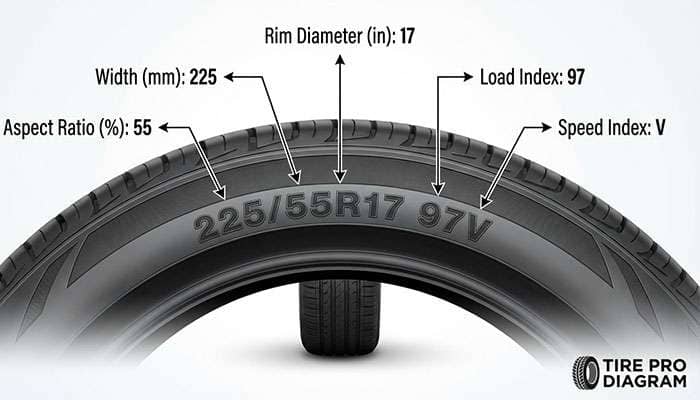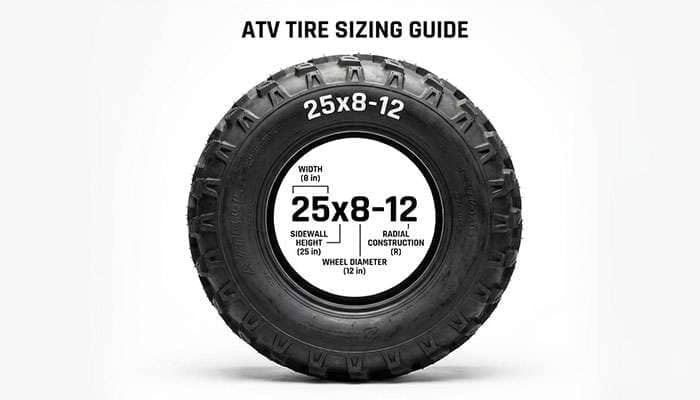
Plus-sizing your wheels and tires can dramatically improve your vehicle's appearance and handling. However, getting the calculations wrong creates serious problems with speedometer accuracy, fuel efficiency, and even safety.
The golden rule for plus-size wheels and tires is staying within 3% of your original equipment tire diameter. Cross this threshold and you're asking for trouble with your vehicle's performance and safety systems.
Tire size plus sizing means swapping your vehicle's original equipment (OE) tire size for a larger one. This popular modification enhances both looks and performance when done correctly. The challenge? One calculation error can lead to speedometer problems, reduced fuel economy, and safety issues.
A plus sizing tires calculator solves this problem. These specialized tools ensure your new tire and wheel combination maintains the correct overall diameter while delivering the upgraded appearance you want. The tire plus sizing formula works consistently across all conversion options, adjusting the numbers to achieve the right new tire size.
At Performance Plus Tire, we understand that proper fitment makes all the difference. Our online subscription guide provides serious enthusiasts with updated fitment information throughout the year, covering both original equipment and aftermarket plus sizes for current and vintage vehicles. The guide includes interactive calculators that convert offset to backspace and compare up to four tire sizes side by side, showing differences in section width, height, outside diameter, and more.
We'll guide you through the step-by-step process of plus-sizing your wheels and tires correctly. You'll avoid common mistakes while achieving that perfect upgraded look you're after.

Plus sizing replaces your vehicle's factory wheels with larger diameter ones, fitted with tires that have lower aspect ratios (shorter sidewalls) but maintain approximately the same overall diameter as the original equipment. This modification started gaining traction in the 1970s when enthusiasts began upgrading their cars from relatively narrow 13-, 14-, or 15-inch wheels to wider 14-, 15-, or 16-inch combinations.
The "plus" tells you exactly how many inches you're adding to your wheel diameter. Plus Zero keeps the same wheel size but increases tire width. Plus One increases wheel diameter by one inch, Plus Two by two inches, and so forth. The basic formula works like this: for each inch increase in wheel diameter, increase tire width by 10mm and decrease sidewall height by 5-10%.
Every tire sidewall displays three critical numbers that determine fitment. The first number represents tire width in millimeters, measured from sidewall to sidewall at the widest point. The second number indicates the aspect ratio—the sidewall height expressed as a percentage of the width. The third number (preceded by "R") shows the rim diameter in inches that the tire is designed to fit.
Take a 225/50R16 tire as an example: 225 is the width in millimeters, 50 means the sidewall height is 50% of the width, and 16 indicates it fits a 16-inch wheel. When plus sizing, you increase wheel diameter while adjusting width and aspect ratio to maintain overall diameter.
Plus sizing appeals to drivers for two main reasons: looks and performance. Larger wheels fill out wheel wells more effectively, creating a more aggressive stance. Alloy wheels are considered more attractive than tire sidewalls, giving the vehicle a more premium appearance.
The performance benefits are real. Shorter sidewalls reduce flex, resulting in quicker steering response and increased cornering stability. The wider tread provides a larger contact patch with the road, enhancing grip and handling. Consumer Reports tests show that increasing wheel diameter by one inch (Plus One) offers the greatest benefit in overall performance.
What started as an aftermarket modification has evolved into a common option offered by dealerships at the time of vehicle purchase. Plus sizing represents one of the easiest ways to enhance both the appearance and performance capabilities of a vehicle.

Plus-sizing wheels and tires correctly requires careful planning and precise calculations. Here's how to get it right every time.
Find your current tire size on the sidewall or check your vehicle's door jamb sticker or owner's manual. The tire size appears as three numbers (for example, 225/45R17) representing width in millimeters, aspect ratio percentage, and rim diameter in inches.
Try this comprehensive Plus/Minus Sizing Calculator to find compatible alternatives that maintain proper speedometer calibration and consistent vehicle handling. These calculators eliminate guesswork and prevent costly mistakes.
Keep your new tire's overall diameter within 3% of the original equipment tire. This tolerance ensures your speedometer remains accurate and your vehicle's systems continue to function properly. Exceeding this threshold causes noticeable problems with speedometer readings, anti-lock brakes, and stability control.
Your chosen tire must fit the wheel width properly. Each tire size has a recommended range of wheel widths it can safely mount on, typically spanning about two inches. Mounting a tire on a wheel that's too narrow or too wide compromises handling, tire wear, and safety. Check manufacturer specifications for your specific tire model before making a purchase.
Beyond calculations, physical clearance matters. Your new wheel and tire combination must clear brake calipers, suspension components, and fenders throughout the full range of suspension travel and steering lock. A wider tire or wheel with incorrect offset can rub against components, causing damage and creating dangerous situations. Test fit before final installation or consult fitment guides specific to your vehicle make and model.
Consider a vehicle with original equipment 225/50R16 tires:
• Plus Zero maintains 16" wheels but increases width to 235/50R16 for improved traction
• Plus One moves to 17" wheels with 225/45R17 tires, offering better handling
• Plus Two jumps to 18" wheels with 225/40R18 tires for aggressive looks but firmer ride
Each step up increases wheel size by one inch while reducing sidewall height to maintain overall diameter.
Minus sizing works opposite to plus sizing - decreasing wheel diameter while increasing sidewall height. This approach proves especially valuable for winter driving. The taller, narrower tire cuts through snow more effectively and rides more smoothly over winter road imperfections.
A vehicle running 225/45R17 summer tires might use 205/55R16 winter tires. The narrower width concentrates weight for better snow traction, while the taller sidewall absorbs impacts from potholes hidden under snow. Minus sizing also reduces the cost of winter wheel and tire packages.

Plus-sizing wheels and tires involves real tradeoffs that you need to understand before making changes. Getting this wrong costs money and creates problems you didn't expect.
Plus sizing delivers genuine performance improvements. The wider tread face and stiffer sidewalls dramatically improve cornering ability and vehicle agility. Tests show that moving from a 15" to 19" wheel can double your grip, especially beneficial on wet surfaces. The shorter sidewalls reduce flex, giving you more predictable cornering with less wallowing.
Larger wheels also offer increased ground clearance, making it easier to handle uneven terrain. For many enthusiasts, the visual impact matters most - larger wheels with lower profile tires create that sportier, more premium appearance you're after.
These benefits come at a price. Larger wheels and tires cost substantially more than stock sizes. The decreased sidewall height means less cushioning, so you'll feel every crack in the pavement. Road noise increases too, as there's less shock absorption.
Fuel economy takes a hit - studies show that upgrading from 15" to 19" wheels can decrease fuel efficiency by 10% in city driving. The additional weight strains your suspension and braking systems, which can actually hurt performance.
Plus sizing impacts important vehicle systems. Your Tire Pressure Monitoring System (TPMS) sensors will still work with different sized tires since they just monitor pressure changes. When changing wheels, transfer these sensors to your new wheels.
Speedometer accuracy presents a bigger concern. If your overall diameter increases, your speedometer reads slower than your actual speed. With tires just 3% larger than original equipment, your speedometer shows 60 mph when you're actually traveling at 63.3 mph.
Many drivers make critical calculation mistakes. These include mixing measurement units (millimeters for tires, inches for wheels), forgetting that sidewall height appears twice in diameter calculations, and assuming tire fitment means diameter match. Another common error involves exceeding the safe threshold for diameter variation - stay within 3% of original equipment diameter.
Seek professional guidance for extreme plus sizing (Plus Two or greater), clearance issues, or significantly wider tires. A tire professional can verify brake caliper clearance and ensure proper wheel offset to prevent rubbing against suspension components or fenders. Professional consultation becomes essential when dealing with performance vehicles or vehicles already modified from stock configuration.
Plus-sizing your wheels and tires stands out as one of the most effective ways to upgrade your vehicle's appearance and performance. The key to success? Proper calculations and staying within that critical 3% diameter threshold to avoid speedometer errors and maintain safe vehicle handling.
Each plus-sizing approach serves different needs. Plus Zero delivers better traction without new wheels, while Plus One offers the best balance of performance and comfort. Plus Two and Three create dramatic visual impact but sacrifice ride quality. For winter conditions, minus sizing provides the taller sidewalls that cut through snow more effectively.
The benefits make plus-sizing attractive - enhanced cornering stability, sportier looks, and better ground clearance. These advantages come with tradeoffs including higher costs, reduced comfort, and decreased fuel efficiency. The impact on your TPMS and speedometer accuracy also requires careful consideration.
At Performance Plus Tire, we've seen too many customers make costly mistakes with incorrect calculations. That's why we recommend using reliable plus-sizing calculators for every modification. These specialized tools ensure proper fitment while delivering the upgraded appearance you want.
Professional consultation becomes essential for extreme plus-sizing or modified vehicles. Our experienced technicians can verify brake caliper clearance and proper wheel offset to prevent rubbing against suspension components or fenders.
Plus-sizing might seem complex initially, but with the right knowledge and tools, you can achieve that perfect combination of style and performance. Take your time with measurements, use the calculators properly, and your vehicle will soon have the upgraded look and handling you've been wanting.
Ready to upgrade your ride? Our expert team is ready to help you find the perfect plus-size wheel and tire combination that fits your vehicle and budget perfectly.
Master the art of plus-sizing wheels and tires with these essential insights to enhance your vehicle's performance while avoiding costly mistakes.
• Stay within 3% of original tire diameter to prevent speedometer errors and maintain proper vehicle handling and safety systems.
• Use specialized plus-sizing calculators to ensure accurate measurements when increasing wheel diameter and adjusting tire width and aspect ratio.
• Plus One sizing offers the best balance of improved handling, esthetics, and comfort compared to more extreme sizing options.
• Consider the tradeoffs carefully - larger wheels improve cornering and appearance but reduce comfort, fuel economy, and increase costs.
• Consult professionals for extreme modifications (Plus Two or greater) to verify brake clearance and prevent suspension component interference.
When done correctly, plus-sizing transforms both your vehicle's appearance and performance. The key lies in precise calculations, understanding the compromises involved, and knowing when to seek expert guidance for complex fitments.
The general rule of thumb for plus-sizing is to increase tire width by 10mm and decrease the aspect ratio by 5-10% for each inch increase in wheel diameter. This helps maintain a similar overall tire diameter.
Use a specialized plus-size wheel and tire calculator to ensure accuracy. Input your current tire size and desired wheel diameter, and the calculator will provide compatible tire size options that maintain the proper overall diameter.
Benefits include improved handling, esthetics, and ground clearance. Drawbacks can include increased cost, reduced ride comfort, decreased fuel economy, and potential impacts on vehicle systems like the speedometer.
It's recommended to stay within 3% of your original tire's overall diameter. Exceeding this threshold can lead to speedometer inaccuracies and affect vehicle handling and safety systems.
Seek professional guidance for extreme plus-sizing (Plus Two or greater), if you're facing clearance issues, installing significantly wider tires, or if your vehicle has already been modified from its stock configuration. A tire professional can verify proper fitment and prevent potential problems.